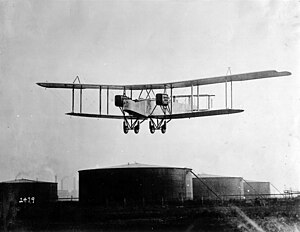Handley Page Type O
| Type O | |
|---|---|
 |
|
| Handley Page O/400 | |
| Role | Bomber |
| Manufacturer | Handley Page Aircraft Company |
| First flight | 17 December 1915 |
| Introduction | 1916 |
| Retired | 1922 |
| Status | Retired |
| Primary users |
Royal Air Force Royal Naval Air Service |
| Number built | 600 |
| Unit cost |
£6,000 (less engines and equipment)
|
The Handley Page Type O was an early biplane bomber used by Britain during the First World War. The Type O was the largest aircraft that had been built in the UK and one of the largest in the world. Most were built in two versions, the Handley Page O/100 (H.P.11) and Handley Page O/400 (H.P.12).
The bombers were used in France for tactical night attacks on targets in German-occupied France and Belgium and for strategic bombing of industrial and transport targets in the Rhineland. Some aircraft were temporarily diverted to anti-submarine reconnaissance and bombing in the Tees estuary in 1917 and two aircraft operated in the eastern Mediterranean. The impression made by the Type O was such that for many years after the war, any large aircraft came to be called a "Handley Page" in Britain and entered the dictionary as such.
The design of the series of aircraft began shortly after the outbreak of the First World War after meetings between the Royal Navy Director of the Air Department, Captain Murray Sueter and Frederick Handley Page. Sueter requested "a bloody paralyser of an aircraft" for long-range bombing. The phrase had originated from Commander Charles Rumney Samson who had returned from the front. Coastal patrol adaptations of the abortive Handley Page L/200, M/200 and MS/200 designs were initially discussed but Sueter's technical advisor, Harris Booth, favoured a large seaplane for coastal patrol and dockyard defence, that would also be capable of bombing the German High Seas Fleet at its base in Kiel. A prototype (AD Seaplane Type 1000) had already been commissioned from J Samuel White & Co. of Cowes.
Handley Page suggested building a land-based aircraft of similar size, and a specification was drawn up around his suggestions and formally issued on 28 December 1914 for four prototypes. It called for a large biplane to be powered by two 150 hp (110 kW) Sunbeam engines, which was required to fit in a 75 ft × 75 ft (23 m × 23 m) shed and would therefore have folding wings. It was to carry six 100 lb (45 kg) bombs and have armour plating to protect crew and engines from rifle-fire from the ground. The crew of two were to be enclosed in a glazed cockpit and the only defensive armament planned was a rifle to be fired by the observer/engineer. The name O/100 came from the proposed wingspan of the aircraft prefixed by an 'O', since Handley Page gave their types alphabetical type letters. The outline design was approved on 4 February 1915, with 250 hp (190 kW) Rolls-Royce Eagle engines and on 9 February the contract was amended to include a further eight aircraft.
...
Wikipedia
